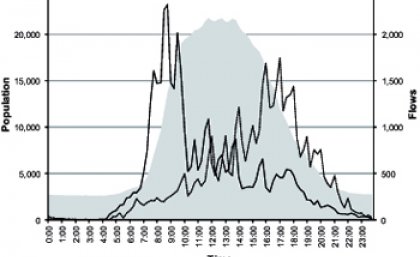
The Queensland Centre for Population Research (QCPR) has revealed that the provision of green infrastructure at The University of Queensland's St Lucia campus has had a major impact on the travel behaviour of the University population.
The QCPR was recently commissioned by UQ’s Property and Facilities Division to investigate the numbers of visitors to UQ’s St Lucia’s campus on any given day and when the peak population period occurs.
While the results of the survey are used for planning of supporting amenities and infrastructure for the campus population, the study method has the added benefit of surveying the mode by which people arrive and leave the campus,” UQ’s Site Planner Mr Ross Meakin said.
It was discovered that more than 10,000 people, many of whom would have previously travelled to campus by car, now cross the Eleanor Schonell Bridge each weekday by bus, on foot, or by bike.
“The development of this green transport infrastructure has contributed tangibly to the sustainability of UQ's St Lucia Campus,” QCPR representative Dr Elin Charles-Edwards said.
“It has improved access to the St Lucia Campus from Brisbane’s southern and eastern suburbs and reduced travel times from the CBD," he said.
Overall, the number of visitors has increased by 7,000 since 2002, when the last survey was conducted.
This growth has been achieved without any increase in the volume of traffic on St Lucia roads with 3,000 fewer people travelling by car than in 2002. Instead bus patronage has doubled and there has been a 70 per cent increase in people travelling by bicycle and on foot.
“This demonstrates the effectiveness of the campus planning principle introduced in the 1996 Site Development Plan aimed at promoting increased participation on public modes of access and co-ordinating with the Brisbane City Council to develop direct links the CBD and suburbs combined with capping of campus car parking,” Mr Meakin said.
“The principle is now firmly recognised as essential to achieve ecologically sustainable development outcomes. It is pleasing to see the planning strategy has been supported by the connection of the Citycat, Eleanor Schonell Bridge and the St Lucia Bikeway," he said.
QCPR calculated the St Lucia population using a combination of infrared and pneumatic counters situated at 10 strategic points on campus, coupled with data from Translink, and an internet survey of staff and students.
The results put the campus population at almost 22,000 on a weekday in the middle of second semester 2011, up by 27 per cent on the figure of 17,140 recorded in a similar survey in 2002.
QCPR found that numbers rise rapidly after 7am, plateau between 10 and 2, then fall steadily.
Underpinning these numbers, there are more than 42,000 movements on to and off the campus every day.
“This is equivalent to a capacity crowd at the Gabba, and confirms that UQ is one of Brisbane’s largest daily traffic generators” Dr Charles-Edwards said.
This project is part of a wide ranging program of research by QCPR aimed at understanding the dynamics of visitor movement and estimating temporary populations.
This is the third study of population on campus in the past 15 years by UQ’s Property and Facilities Planning Section.
“In addition to assisting with campus planning, the continuation of this survey on a regular basis will assist with ongoing benchmarking against sustainable transport targets,” Mr Meakin said.
Media: Kate Swanson (School of Geography, Planning and Environmental Management), 07 3346 7406 or k.swanson@uq.edu.au.
.jpg)









